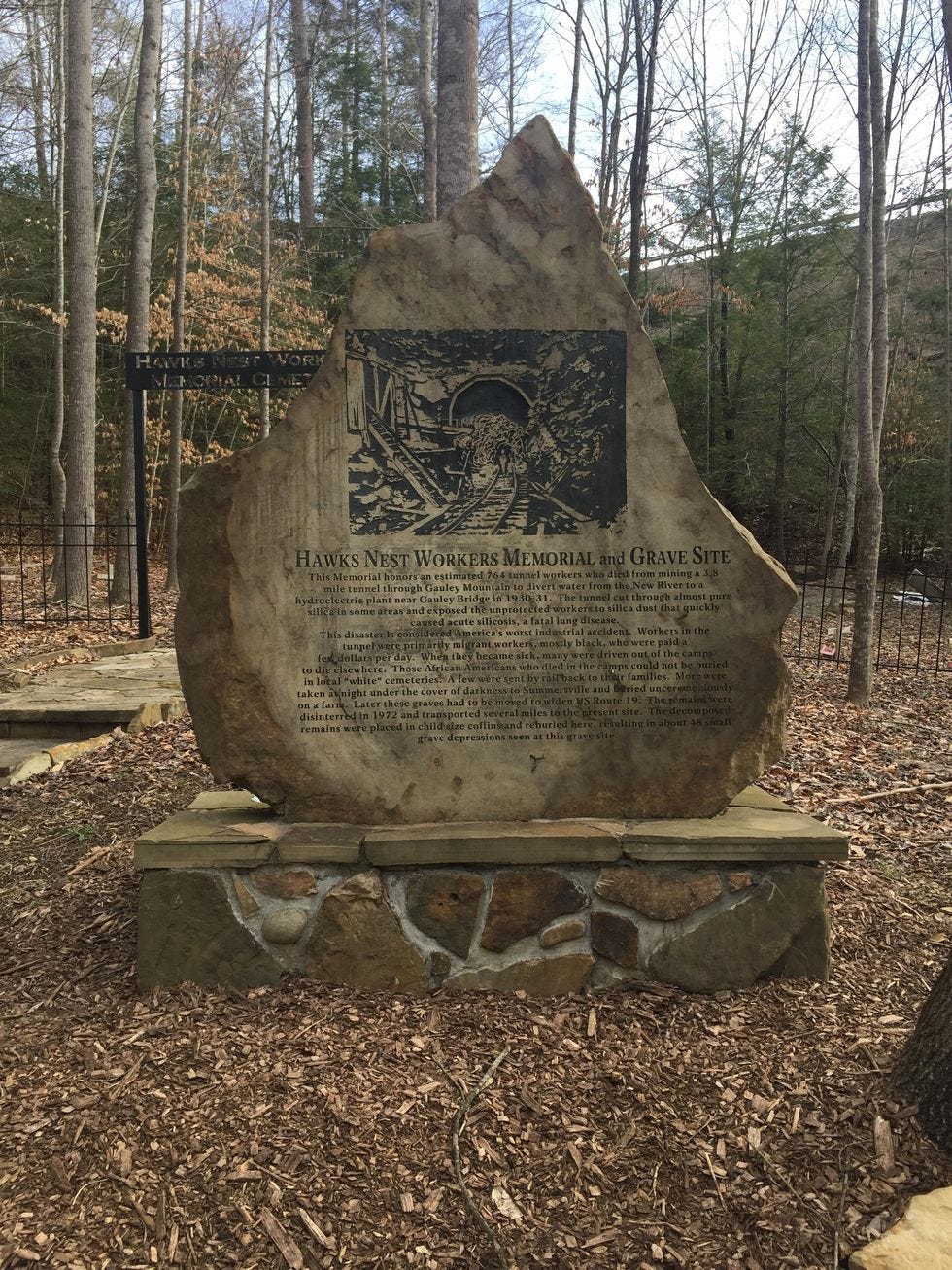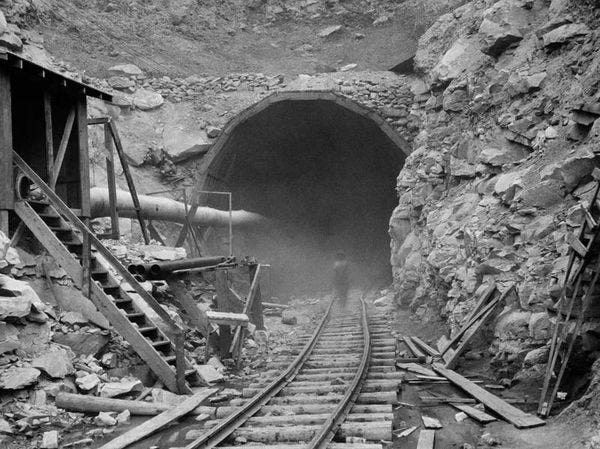Almost Today In Labor History: The Hawk's Nest Tunnel Disaster, 1931
Time to learn the things!
Note: This was supposed to run yesterday on the actual anniversary of the Hawk's Nest Tunnel disaster, but Yr Editrix forgot, and she feels very bad about that.
On March 30, 1930, the Hawk's Nest tunnel project near Gauley Bridge, West Virginia, began. This tunnel was designed to divert the New River to help Union Carbide increase its energy efficiency at a downstream plant. However, this mountain contained an unusual amount of silica. The largely Black workforce were not given any protection. While in normal cases, it takes years for silicosis to develop and kill a worker, of the 3,000 workers, perhaps up to 1,000 died of silicosis, some within a year. This is one of the more horrifying workplace safety disasters in American history, one created by racial prejudice and the complete indifference of white employers to Black workers dying.
To build this project, Union Carbide contracted with a Charlottesville, Virginia, construction company to recruit labor. As was common for hard labor projects, most of the workers were Black, and they came from around the Southeast. As was also common, Black workers labored in more dangerous conditions with fewer safety protections and were housed in segregated housing.
The company didn't expect there to be this much silica in the rock. When the high silica rates were discovered, the company was thrilled because the deposits were dense enough that they could be sold commercially for steel production. Thus, the company expanded the radius of the tunnel to make more money. Drilling and blasting were the standard ways to create tunnels. It can be done with a lot of water. Wet drilling reduces the dust and thus the silica. But this did not happen at Hawk's Nest, in order to save costs. The whole point of the tunnel was to divert a river, so it's not as if water was not available. Moreover, the workers were immediately sent into the mine to gather the blasted rock instead of allowing the dust to settle. Once again, the employers simply did not care because these were largely Black workers.
After six-day weeks of workers breathing in silica-laden dust, their health deteriorated quickly. The tunneling work ended in September 1931 and the entire project was completed in 1934. It did not take long for workers to begin dropping dead — as early as the first half of 1931. The survivors, many of whom were also horribly sick, began to file lawsuits against their employer in 1932. By mid-1933, the contractor faced lawsuits with a total liability of $4 million. It agreed to settle out of court, paying a total of $130,000, half of which went to the attorneys. The compensation was much higher for the relatively small number of exposed white workers than it was for Black workers. The judge determined that a single Black man would receive only $400 and a married Black man $600 while a single white man got $800 and a married white man received $1,000. During this whole process, there is significant evidence that the contractor worked to bribe witnesses and tamper with juries. However, precision is hard with this story because the contractor later destroyed all the records, including any information about the afflicted workers.
By the time the tunneling was done, many of the workers were too sick to return home and they died nearby. The contractor threw their bodies into unmarked graves without identification, hiring a mortician at twice the normal rate for paupers to deal with the problem quietly. Even when they could find the families, they just buried the bodies in mass graves. George Robison later testified, "I knew a man who died about 4 o'clock in the morning in the camp and at 7 o'clock the same morning his wife took his clothes to the undertaker to dress her dead husband and when she got there they told her the husband had already been buried." Between 750 and 1,000 people died of silicosis on the Hawk's Nest project in the years after it. About three-quarters were African-American, with the rest made up of local whites.
This tragedy was so profound that even though it was mostly Black workers involved in a deeply racist America, it received national attention. A few local newspapers reported on the deaths in 1931, but Union Carbide intimidated the journalists and squashed the story. But it received attention when Albert Maltz, a screenwriter later blacklisted as one of the Hollywood Ten, became aware of the story and wrote a successful short story about it in New Masses that featured a white (unsurprisingly) worker who got sick in the tunnel. This brought it broadly to the attention of the Left and then the nation. The People's Press reported on the incident, trying to raise money for the survivors. It wrote in 1936:
"In the name of greed, 476 men—at least—are dead. Another 1,500 are doomed of whom 200 probably are dead in other places.
The dying are unable to get state or federal relief.
The doomed who can still work cannot get jobs. Employers know they are doomed.
The wives and children of the dead, the families of the dying and the doomed live at the edge of the starvation line.
Greed put them there.
In the name of humanity, the People's Press asks you to help them.
Any sum, large or small, $100 or 1¢ will make life a little easier for this Town of the Living Dead.
They will not get help from the millionaires who kill 2,000 men for a few dollars. That we know.
So we urge you to help them. Everything given will go directly to these people in desperate need."
Josh White, performing under the pseudonym Pinewood Tom, also recorded "Silicosis Is Killin' Me," about the dead Hawk's Nest workers, in 1936.
That same year, a congressional committee launched an investigation. There it was revealed that the engineers and bosses knew there was a severe risk of silicosis. They protected themselves by wearing masks. But they of course gave no masks to the workers, even though this is an incredibly inexpensive form of protection. The committee was deeply critical of Union Carbide and the contractor. But they took no action against the perpetrators. The worried mining companies did what timber companies, railroads, and other employers in dangerous workplaces had done since 1911, which was lobby to include their workers under state worker compensation programs. Those programs largely existed to protect employers from lawsuits and liability , providing very limited compensation to workers that fell far below the money they made on the job. West Virginia added tunnel diggers in 1935 with relatively long employment periods that excluded short-term workers so that companies would not have high liability rates in the future.
This would not be the last time Union Carbide was involved in a massive industrial disaster.
When US Highway 19 was expanded to four lanes in 1972 north of Fayetteville, West Virginia, construction workers uncovered one of the mass graves with 41 bodies. They were reburied off the highway. Finally, in 2012, there was a ceremony and marker placed to honor the dead. No one knows their names. And no one ever will. Such is a piece of the story of American racism. There are other Hawk's Nest victims mass graves around the region, although I don't believe any have this level of commemoration. I happened to be in the area a few years ago and I stopped to pay my respects to those so mercilessly killed by a system of racist capitalism.

Hawk's Nest memorial photo by Erik Loomis

Photo by Erik Loomis
Why It Matters:
Silicosis is still a problem in the American workplace. After a 40-year struggle, the Obama administration finally created a new silicosis standard to protect workers. The Trump administration briefly attempted to repeal it in 2017, but gave up soon after.
But even more important to us today is the connection between masks, race, and disease. It's ironic to write about this during the COVID-19 pandemic, when essential workers have been marginalized. Sure, we call them heroes. But did a grocery store worker ask to be a hero? No. They asked to have a job. They asked to not die on the job. That many of these "heroes" are workers of color making a low wage is all too typical of how racial and labor oppression overlap.
Moreover, the entire "heroes" rhetoric contributes to undermine actual claims to advancement and power by workers. Heroes aren't supposed to get paid what they deserve. They aren't supposed to strike. They aren't supposed to protest. They are supposed to sacrifice for us. That's what this hero rhetoric in the COVID-era has been about. We "thank" them for their service. Meanwhile they are making minimum wage or a little above and we don't put any effort behind their union campaigns or ensuring they receive higher wages. We might vote for Joe Biden to be president, but supporting workers requires a lot more from us than that. That so many grocery workers got sick and died during the COVID pandemic when the Trump administration told us not to wear masks is all the more telling. We know that just as Black workers died at astronomical rates at the Hawk's Nest project, they have died at much higher rates than whites during the pandemic, both from lung-based illnesses, both entirely preventable, both exacerbated by racist systems of work and life in America.
Further Reading:
Martin Cherniack, The Hawk's Nest Incident: America's Worst Industrial Disaster [1986]
David Rosner & Gerald Markowitz, Deadly Dust: Silicosis and the On-Going Struggle to Protect Workers' Health [2006]
Do your Amazon shopping through this link, because reasons .



